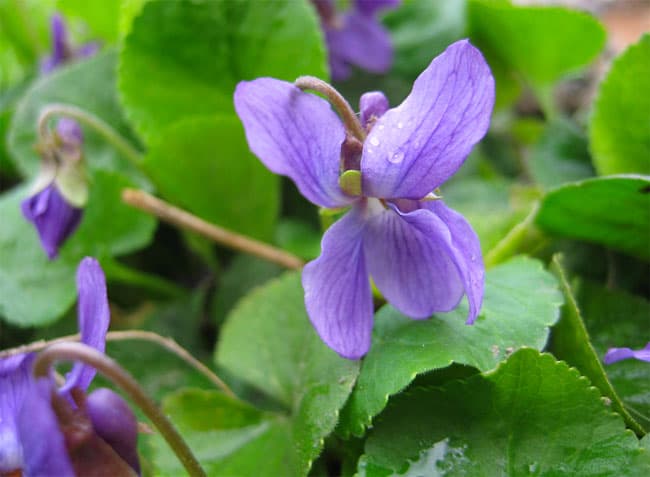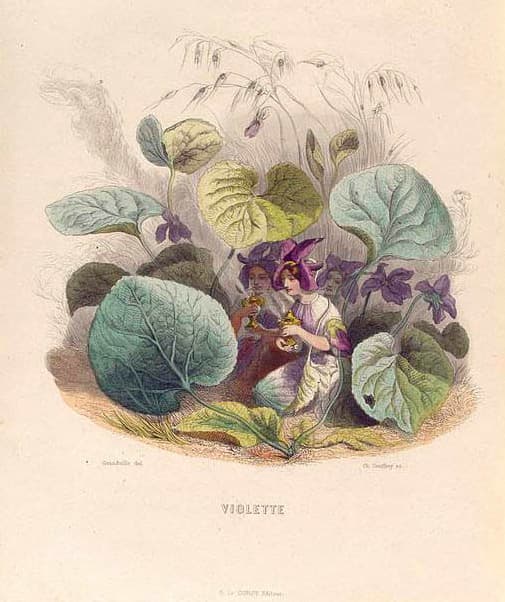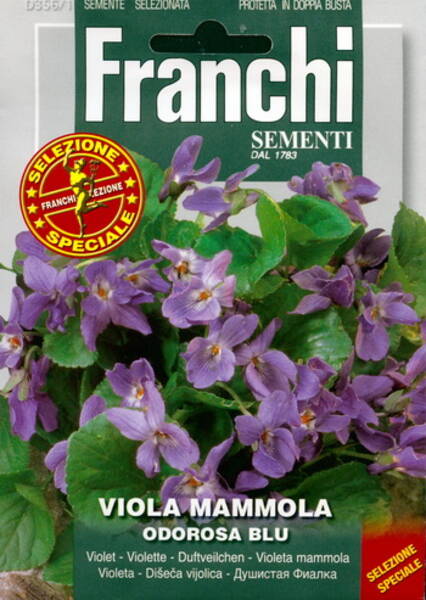A perennial plant with an excellent delicate scent. It is low-maintenance and undemanding. Plant height is 10-25 cm.
Sweet violet is used as an ornamental plant for flower beds, borders, and for cutting. It can be planted in the shade of shrubs, trees, or near water bodies.
Growing Instructions.
Sweet violet prefers cool, shady (semi-shady) locations with high humidity and fertile, moist soil. Seeds that have been stored for some time are dormant. To achieve good, uniform germination, seed stratification in several stages is necessary.
Seeds are sown onto carefully prepared, moist soil without covering, "under glass." The soil must be kept constantly moist at +18+22°C for 2-4 weeks. Next is the stratification period: cooling to -4°C for 4-6 weeks or until germination. Then, the temperature must be increased to +5+12°C.
When the first true leaf appears, the seedlings are pricked out. They are planted in their permanent location in August. Freshly harvested seeds are sown in spring or autumn in open ground. When the first true leaf appears, the seedlings are pricked out. They are planted in their permanent location in August. Young plants are covered with spruce branches for the winter.

* Sweet Violet - Viola odorata L.
Native to - the European part of Russia, Crimea, Caucasus, Western Europe, the Balkans, Asia Minor, the Mediterranean.
A perennial plant up to 15 cm tall with creeping, easily rooting stems. Leaves on petioles, heart-shaped, bluntly toothed, up to 6 cm long, collected in dense clusters. Flowers up to 2 cm, simple or double, violet, less often white, with a strong pleasant aroma. Blooms in May for up to 25 days, sometimes again in autumn. Moisture-loving, but suffers from waterlogging. Winter-hardy, but in snowless winters it can freeze, so preventive covering with spruce branches is recommended.
Location: prefers sunny spots, loose, fertile soils. Sweet violet tolerates light shade, but abundant flowering is observed in illuminated areas.
Soil: grows and flowers better in rich, moist, well-drained soils. During dry weather, watering is necessary, otherwise the flowers become smaller and flowering stops.
Care: reacts negatively to fresh organic fertilizers. Pinching off fading flowers prolongs flowering.
Perennial violets are propagated by sowing fresh seeds in open ground in autumn. Seedlings appear in the spring of the following year. They can also be propagated by dividing the bush and by cuttings. It is not recommended to cultivate them for more than three years without division, as the bushes become overgrown, lose their compactness, and the flower size decreases. If seed pods are not removed, violets will produce abundant self-seeding. Their seedlings appear in autumn and the following spring. If seedlings are transplanted in time, you can have pansies in the garden without special sowings.
Sweet violets are especially good in small spring bouquets. Some violets, including the sweet violet, are used for forcing.
In autumn, plants are planted in pots, kept in a cold room until mid-October, and then moved to a cold greenhouse with a temperature of 8-10°C. When the plants start to grow, they are placed closer to light but away from a heat source and begin to be watered abundantly and sprayed with warm water. They bloom in a month.
Companions: combine well with primroses, arabis, squills, muscari.

Grandville.
Eng.: Sweet violet, blue violet, English violet, garden violet, purple violet, sweet-scented violet.
* The rhizomes of sweet violet contain saponins, alkaloids, essential oil, nitrogen-containing compounds, flavonoids, and phenolcarboxylic acids.
The leaves contain essential oils, saponins, steroids, triterpenoids, flavonoids, and phenolcarboxylic acids.
The flowers have been found to contain organic phenolcarboxylic and fatty acids, essential oil, and saponins.
The plant has anti-inflammatory, analgesic, expectorant, sedative, antimicrobial, and antispasmodic properties.
An aqueous infusion of the herb with rhizomes and roots is used for bronchitis, pneumonia, pulmonary tuberculosis, cystitis, kidney and gallstones, urethritis, metabolic disorders, and rheumatism.
As a sedative, sweet violet is used for headaches, insomnia, neurosis, hysteria, and epilepsy.
A decoction of the rhizome is used for gargling with sore throats and stomatitis pustules. It is also used to smear the oral mucosa in children with thrush and is used as a preventive measure for influenza.
An infusion of the leaves is used for cancerous diseases of the larynx and tongue, as well as to prevent ulcers from turning into cancer in the gastrointestinal tract.
An infusion of leaves with honey is used for coughs, stomatitis, and colitis.
Fresh crushed leaves are used for purulent wounds, boils, and dermatitis.
An infusion of flowers is prescribed as an anti-inflammatory, analgesic, and sedative for pneumonia, convulsions, tinnitus, dizziness, and memory loss.
! Warning: the plant is poisonous.












